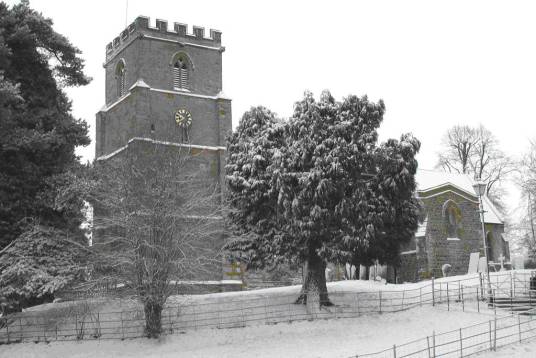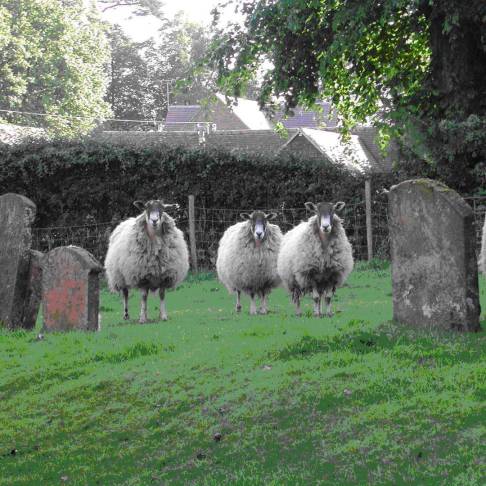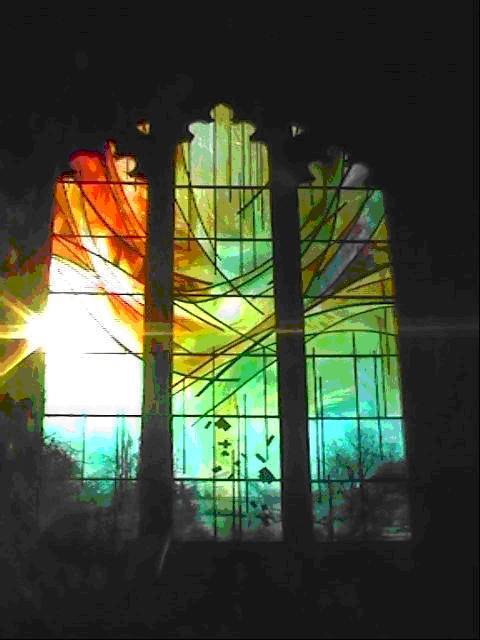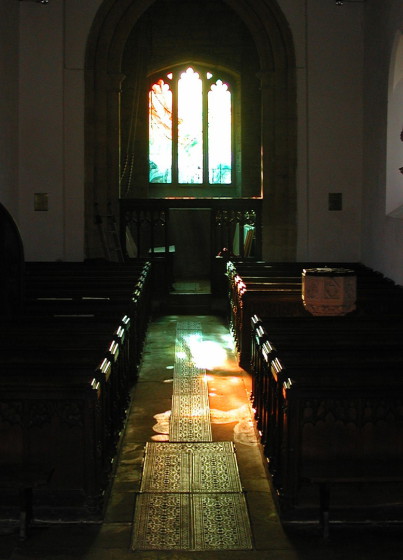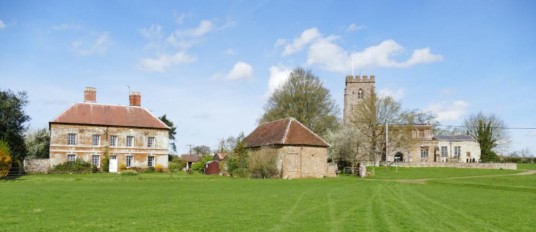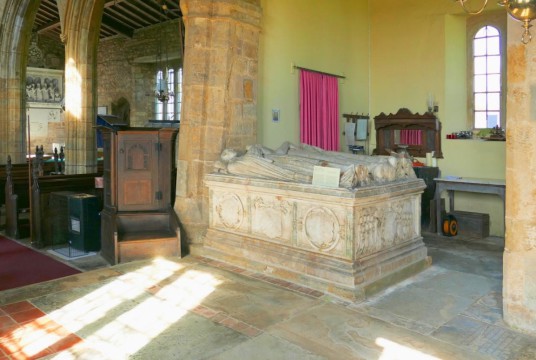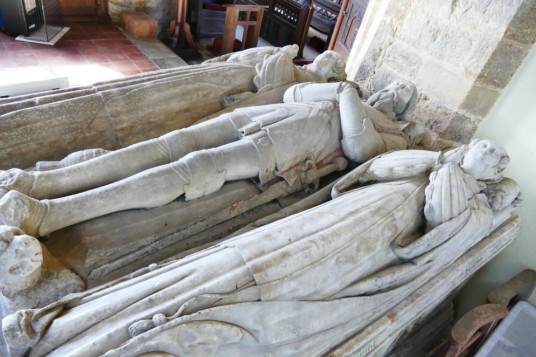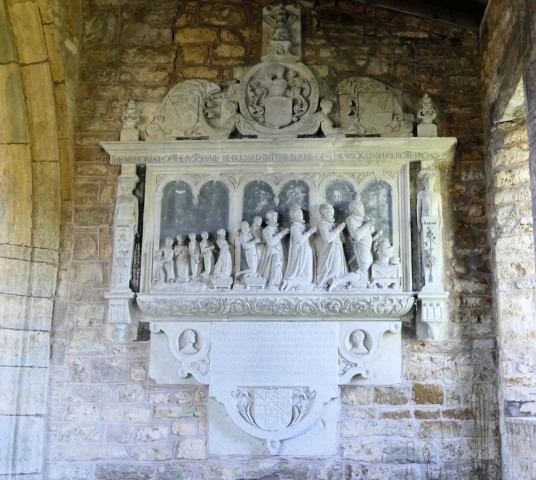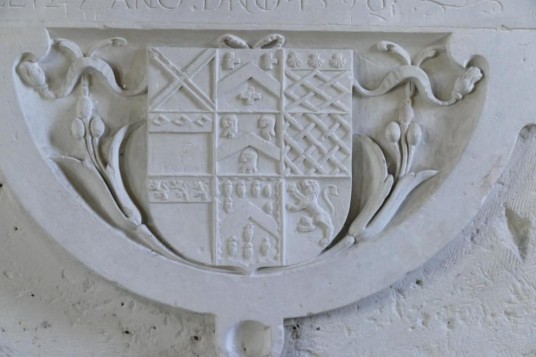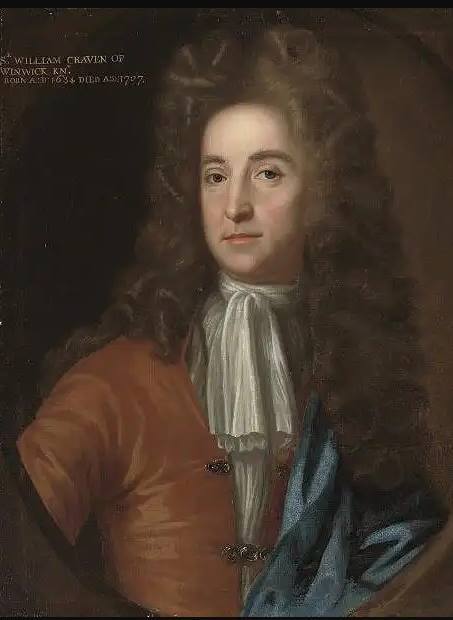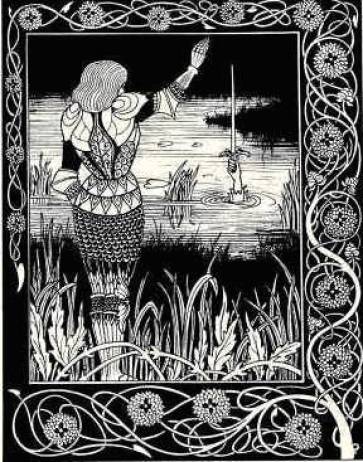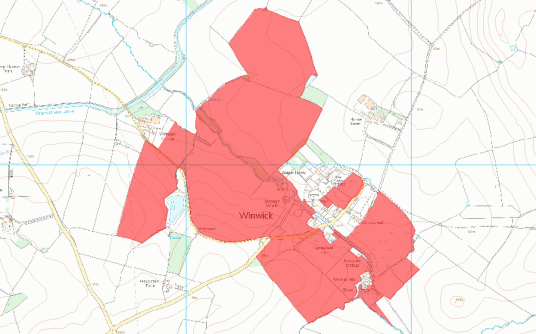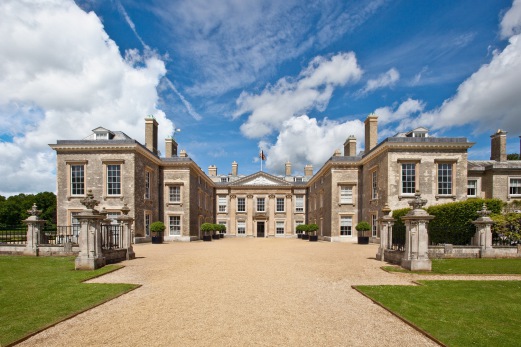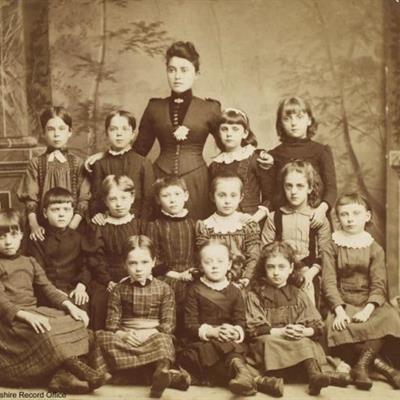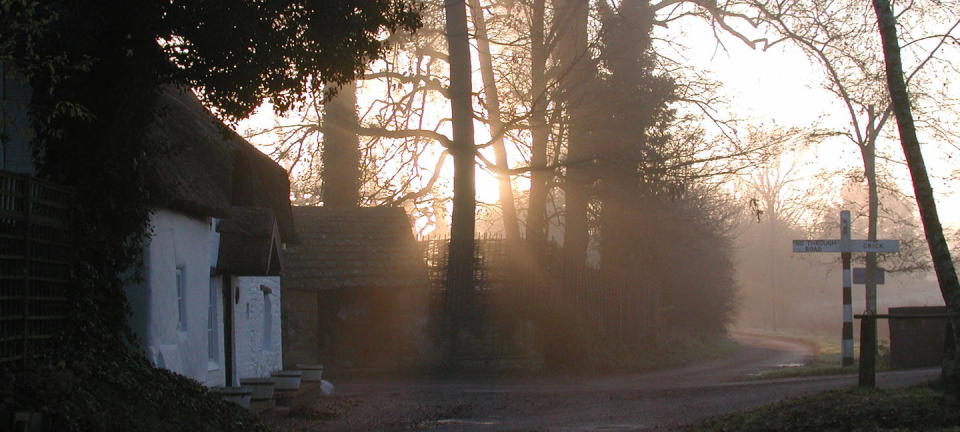
About us
On this page:
- Location
- Our Church
- Our Churchyard
- Our Window on the World
- Domesday Book
- Manor of Winwick and Andrew Family Connections
- Early History
- Le Morte d'Arthur
- Walk Right In (Jurrasic Way)
- The Battle of Naseby
- Medieval Settlement
- Community Flood Plan
- Althorpe House
- Family History
Location
We are part of the West Northamptonshire Uplands, a landscape characterised by rounded, undulating hills with low ridgelines and wide views from the ridgetops. The area is of outstanding interest for its ancient ridge and furrow fields, examples of which can be found close to the village. Natural England provide an excellent summary of the characteristics of the Northamptonshire Uplands on their website.
The area around Winwick has been designated a Special Landscape Area by Northamptonshire County Council in their County Structure Plan 1996 to 2016. This in turn is recognised by Daventry District Council in their planning development policy EN1.
A Special Landscape Area is designated because of it's:
- Scenic quality
- Sense of place
- Unspoilt rural landscape free from urban intrusion, with a sense of remoteness and tranquility
- Landscape particularly representative of type, having fragile condition or scarcity value, or with ancient characteristics
Our Church
Our 13th century church, St Michael and All Angels is the centre of our community and beautifully situated on a grassy mound overlooking peaceful countryside.
The chancel was taken down in 1853 and a larger one built. This was the work of the rector, Rev A. Bromhead and his wife. They also built a Rectory (now Winwick Hall) and the Old School adjacent to the church gate. In the south trancept is an old barrel organ given to the church by Mrs Bromhead. It is still in usable condition.
The North Transept has an unusual memorial, in both Latin and English which is very rare. This memorial and also the black stone in the centre of The Church are by Edward Stanton, a well known 18th century sculptor. The other memorial in the North Transept is by local sculptor Samuel Huskisson.
The Church registers go back to 1567. For some years during the 17th Century, there were many more marriages in Winwick than there were bachelors and spinsters in the Parish. It seems that Winwick was something of a Gretna Green for runaway couples in Northamptonshire – probably because they could get married here without the usual requirements of residency beforehand. Handy if the bride was in … a delicate condition.
Our Churchyard
Our churchyard overlooks miles of unspoiled countryside and is particularly lovely in Spring, when the 2,000 daffodils planted for the new millennium are at their best.
The bench outside the church is a perfect spot to see foxes, woodpeckers, badgers and deer. Keep an eye open too for our resident kingfishers, and don’t miss the ducks in the stream. The rural scene is enhanced by sheep grazing in the churchyard.
Our Window on the World
No visit to Winwick would be complete without a glimpse of our new stained glass window in the West wall of the church. Commissioned by the village to mark the new millennium, the window is a gift of love to future generations. The striking design has already been described as being of national importance.
Jane Campbell, AGMP, Designer and Craftsman in Glass, offers visitors this insight into the window.
“An aerial view outlines the village with roads, fields, a stream and the church, which is highlighted. The view leads on to the rural scene of field and trees seen outside the church and throughout the village.
Colours here evoke the tranquility of Winwick and the glory of God, depicted in seasonal shades of autumn through to spring.God’s love comes down from above in golden colours encompassing the village. This shows that God’s love is for everyone. We can all feel included and relate personally to God’s love in our own lives and our own surroundings”.
Domesday Book
|
Xll. THE LAND OF THE CHURCH OF COVENTRY IN GUILSBOROUGH HUNDRED AND A HALF • THE ABBEY OF COVENTRY holds 3hides and 1 virgate of land in WINWICK. There is land for 6 ½ploughs. There are in demesne 3 ploughs; and 16 villans and 5 bordars, with a priest, have 3 ploughs. It is worth 50s. • In COLD ASHBY the abbey holds 2½ hides, and they belong to Winwick. There is land for 5 ploughs. There are 4 villans and 5 bordars with 2 ploughs. It is worth 10s. IN 'ALWARDSLEY' HUNDRED • In KILSBY the abbey holds 2 hides. There is land for 5 ploughs. In demesne are 2 [ploughs], and 3 slaves; and 10 villans and 8 bordars with 3 ploughs. There are 8 acres of meadow. It is worth 50s. • In WEST HADDON the abbey holds 2 hides. There is land for 4 ploughs. There are 4villans, with 2 bordars and 4 sokemen; they have 4 ploughs. It is worth 20s. 1 of these hides renders soke in Winwick. |
It was King William I, who at a council in Gloucester at Christmas 1085,
ordered the great survey of the nation that was to be called the Doomsday Book. He wanted to know how his land was occupied and with what sort of people, how many cattle and what it was all
worth.
He sent his men all over England, into every shire and had them find out how many hundred hides there were in the shire or what cattle and land the king had himself, and what dues or taxes he might
expect in a year from the shires. Astonishingly, the whole project only took 21 months to complete.
Our village appeared as Winewic in the Guilsborough Hundred. Our value in taxes - just fifty shillings (£2.50). This means we were a bigger tax raiser than our now larger neighbouring village of West
Haddon (Eddone), valued at twenty shillings (£1.00).
Manor of Winwick and Andrew Family Connections
By Geoffrey Andrews
The period following the Norman conquest of England, as with the previous invasion by the Danes, was traumatic as a new social order, in most cases brutally, suppressed and replaced the existing Anglo Saxon system of land ownership with new overlords. The official language changed instantly to coarse French whilst the timber and thatched halls were replaced by intimidating stone castles and the wonderful architecture of the new cathedrals and monasteries all over the country. Winwick was no exception to these events. There was little of politely purchasing or marrying heiresses and widows to gain land, this was a Norman land grab at the point of a sword.
Before 1066 the manor of Winwick at the time of Edward the Confessor (reigned 1042-1066) the freehold was held by Leofric Earl of Mercia (died 1057) (husband of Lady Godiva) who founded the Benedictine Priory of Coventry. It was many years of fighting before all of England was under the control of William the Conqueror after defeating King Harold Godwinson (reigned Jan to Oct 1066) at Hastings but the southern and midland counties succumbed first. In 1086 when the recorded number of households in Winwick was only 23 the Norman Tenant in Chief was William Peverel (Guillaume Pevrel listed in the Battle Abbey Rolls) and the Lord was Drogo of Stoke. In the first year of the reign of Henry 1st (1100) Winwick was in the possession of Stephen de Blukevil who gave houses, land and Winwick Grange to the abbey of Pipwell. During the reign of Henry 2nd (reigned 1154 - 1189) in addition to land held by the monks of Coventry, 8 virgates were also held by Robert Alegod. The estate in Winwick belonging to the Priory of Coventry was in the possession of John de Bayeaux in the time of Henry 3rd (reigned 1216 -1272).
From later generations of the established de Blukevil family their estate passed to the Mallory family. They in the 16th year of the reign of Edward 1st (1288) held lands of Elias de Rabayne. The estates continued in the possession of the Mallory family and in the 9th year of Edward 2nd (1316), Sir Stephen Mallory was lord of Winwick which in 1347 accounted for one tenth of a Knights fee, which reflects the still very small size and economy of Winwick at that time. (This was just 4 days - as a knights fee was the amount of tax calculated to pay for a knight and supporters for 40 days). Winwick was continually held by the Mallory family until Nicholas Mallory died in 1513. He was succeed by his two daughters, Dorothy who first married Edward Cave and Margaret who first married Clement Cave.
It was Sir Thomas Mallory who died about 1470 whilst languishing in prison who is credited with having compiled Le Morte d’Arthur, the legends of King Arthur published after Mallory’s death in 1485 by William Caxton.
Whilst Margaret did not have any children, Dorothy and Edward had two daughters, Katherine and Margaret, who succeeded to the Winwick estate as co-heirs. However, Margaret had no children and upon her death the estate therefore passed to Katherine and thus to her husband Thomas Andrew of Charwelton in right of his wife.
The Andrew family dates from the 13th century in Lancashire, Yorkshire, Warwickshire and from about 1417 in Northamptonshire. For five generations they held the two manors and estates in Charwelton becoming very successful in the booming wool industry. They also held the manor of Harleston (purchased in 1500) amongst others. Winwick came into their possession by the marriage of Thomas Andrew in 1542 to Katherine Cave but also in that year he additionally purchased the monastic properties after the Dissolution of the Monasteries under Henry 8th. This was facilitated by Thomas’ uncle Richard Andrew, of Woodstock, Oxfordshire, who was one of the largest brokers for the sale of crown Monastic properties. Thus Thomas Andrew became the first sole owner of Winwick.
The church at Charwelton contains fine brasses and alabaster monuments to the family each of whom was named Thomas. Both Thomas and his wife Catherine Cave are buried and have effigies on a fine alabaster tomb in the church. It was this Thomas Andrew who died in 1564 who began the construction of the new Elizabethan Manor at Winwick. The manor was not completed in his time as his Will mentions building materials at Winwick. It was his son Thomas who died in 1594 who completed and first lived in the new manor from about 1569.
Each of the five Thomas Andrew’s had at times been Sheriff of Northamptonshire. It was Thomas Andrew (d 1594) whilst living at Winwick who was sheriff at the time Elizabeth 1st finally signed the death warrant of her conspiring cousin Mary Queen of Scots. Her execution took place at Fotheringhey Castle on February 8th 1587. As sheriff it was Thomas Andrew who had to make arrangements for her execution. “For his courtesy to the Queen she gave him a crucifix before going to the block; his function included procuring two surgeons to embalm the queen's body, and burying her heart and other internal organs 'in a secret place known only to himself' - something he is said to have done so successfully in the cellars of the castle that the burial site has never been discovered”.
And so we see that little Winwick is famous for both giving us England’s most legendary king, King Arthur by Sir Thomas Mallory in 1485 and for the organising of the execution of a Queen just over one hundred years later in 1587.
Thomas Andrew died in 1594 and was buried at Winwick but is commemorated by a magnificent wall memorial at Charwelton which shows his two wives and each of his eleven children two of whom died in infancy. He was succeeded by his eldest son Eusebius Andrew who married Anne Knightley. However, he was the last of the Andrew family to live at Winwick as the estate was sold to his son in law Seymour Knightley. Eventually in the 17th Century Winwick came into the possession of the Craven family. However the Andrew connection did not end there.
William Craven, was perhaps the wealthiest man in England and a close friend of Charles 2nd , he provided much of the finance for the king. In addition to Winwick, William also owned the largest house in London at Drury Lane with its magnificent gardens. A branch of the Andrew family via an appointment as Lieutenant Governor of Guernsey in 1545 had become resident there. The name changed to Andros as the local population of the islands spoke predominantly French. Sir Edmund Andros who was in exile with Charles 2nd in Holland was also a friend of William Craven whilst they were there. Sir Edmund later became the Governor of New York taking over the colony from the Dutch and later Governor General of the Dominion of New England and also Governor of Virginia. He married Mary Craven, William Craven’s sister in 1671 and always stayed with William Craven when in England. Sir Edmund even possibly staying sometimes with his friend at Winwick Manor built by his family.
© Geoffrey Andrews 2023
For further information about Winwick Manor and the Andrew family see: Landed Families Blogspot section 138.
For a brief introduction to the Danish and Norman invasions of England see: British Library The Danish and Norman Conquests of England
References:
Associated research by Lorraine Hinschen
Landed Families web site- Nick Kingsley
History and Gazetteer of Northampton - Whellen 1849
Norman Conquest of England - British Library various works
British History on Line
Visitations of Northamptonshire 1618
History and Antiquities of Northamptonshire - George Baker 1830
Amias Andros and Sir Edmund his son - Edith Carey
With thanks to David Pound for access to Charwelton Church and leaflets
Open Doomsday - Anna Powell-Smith
Battle Abbey Rolls
Letters and Papers, Foreign and Domestic, of Henry VIII
Northampton Record Society
Photo Gallery. All photographs by Geoffrey Andrews ©
Early History
As the sun sank on the Battle of Hastings in 1066, the Saxon villagers of Winwick were leading their oxen home from the fields and attending to the evening milking.
The village of Winwick, or a large part of it, lay further downstream then, beyond The Church. It was dominated by a moated building traditionally known as The Old Manor, and of which only the outlines now remain.
That part of the village was ploughed over in the Middle Ages – not by the villagers themselves, but by the Monks of Pipewell Abbey who had been left 180 acres of land by an early landowner, Ralph de Blukeville.
As members of the Cistercian Order, the Monks demanded seclusion from the world – and so the original villagers of Winwick had to move!
They did so – upstream of the mound on which The Church now stands, and which may have been the centre of their community from the beginning. Certainly the mound, or moot had always been a place of meeting and worship.
We know for a fact that in 1085 at the time of the Doomsday Survey, there was already a Priest in Winwick. And by the 13th Century we had ‘a stout stone Church and a Watermill’ too.
During the 15th Century, Sir Thomas Malory, famous for Le Morte d’Arthur, a compilation of tales about King Arthur and The Knights of The Round Table, lived in Winwick whilst an MP in Northamptonshire.
A colourful figure, he wrote most of the first book whilst languishing in prison. In 1485 it was published by our first English printer, William Caxton, and forms the basis of all English language Arthurian books, poetry, films and musicals produced ever since.
Malory’s great-great granddaughter inherited the estate, and it was her husband, Sir Thomas Andrewe of Charwelton who built the present Winwick Manor and Tithe Barn in the 1550s.
On the imposing arch at the entrance of The Manor, Sir Thomas left his family crest for all to see – a blackamoor’s head complete with earring.
Sir Thomas’s ancestor Sir Robert Andrewes (1026 – 1076) settled in Winwick after the Norman Conquest and married a local girl. See the article above for more about this family's connections to Winwick. In 2010 we had a visit from Sir Robert’s 27th Great Grandson. Richard Andrews was over from near Seattle in the USA to discover his roots. We have kept in touch with Richard ever since. In fact he recently contributed to the Winwick Warbler magazine.
For the greater part of the 17th Century the swashbuckling Lord William – later Earl – Craven owned the land. He leased it to his cousin and his new wife, William and Mary Craven – and it is they who lie under the black marble slabs in the nave of the Church. The portrait above was described as ‘Portrait of Sir William Craven, of Winwick, Northamptonshire (1634-1707), bust-length, in a brown coat and blue mantle, in a feigned oval’ when it was sold at auction by Christie’s in 2007.
Throughout this time the parish remained agricultural. The Miller was the only man involved in anything approaching industry.
Agriculture is still the main occupation within the parish, just as it was 1,000 years ago. There are roughly the same number of households here today as there were in 1085, but these days residents pursue careers outside the village, rather than toiling in the fields or working at The Manor. The Mill no longer grinds the parish corn, and a taxi takes the children to school elsewhere.
Le Morte d’Arthur
On a literary theme, one of the many reasons people visit our village is our association with Sir Thomas Malory, who was Lord of The Manor in
Winwick.
It was Malory who wrote “Le Morte d’Arthur”, which was printed by William in 1470.
Malory’s book is the forerunner of Tennyson’s “Idylls of The King”, and indeed of every tale ever told of the
Knights of The Round Table.
British Library - Thomas Malory
Walk Right In
Many people visit Winwick as they walk the Jurassic Way, a long-distance recreational footpath that meanders across Northamptonshire and through the village.
The 88 miles of the Jurassic Way are renowned for beautiful countryside, fossils and rocks from 140 – 195 million years old.
The Battle of Naseby
On June 14th 1645, with the English Civil War in full swing, a decisive battle took place in the rolling fields of Northamptonshire.
Within three hours, the Civil War was decided, a King and a kingdom were lost, and the foundations for a republic were laid.
Naseby is just six miles from here – indeed it is claimed that men from Cromwell’s cavalry slept in the Tithe Barn in Winwick on the eve of the battle.
The battle site is well worth a visit.
More Naseby links at: The Naseby Battlefield Project and UK Battlefields Resource Centre
Medieval Settlement
Thanks to the research and report by English Heritage, the Secretary of State for Culture & Media has decided to add the medieval settlement at Winwick to the National Schedule of Monuments.
The medieval village site at Winwick which is first mentioned in Domesday, was recommended for designation for the following principal reasons:
- Survival: for the exceptional earthworks and buried deposits depicting the form and plan of the settlement and its associated agricultural practices;
- Potential: for the stratified archaeological deposits which retain considerable potential to increase our understanding of the physical characteristics of the buildings and settlement. Buried artefacts will also have the potential to increase our knowledge and understanding of the social and economic functioning of the settlement within the wider medieval landscape;
- Documentation: for the high level of historical and archaeological documentation pertaining to the settlement's evolution;
- Group value: for its close proximity to a number of listed buildings but particularly to the C13 Church of St. Michael;
- Diversity: for the range and complexity of features such as building platforms, crofts, trackways, and moated platform which, taken as a whole, provide a clear plan of the settlement and retain significant stratified deposits which serve to provide details of the continuity and change in the evolution of the settlement.
I can send anyone interested a copy of full 2014 English Heritage report. Please get in touch via the Contact Form on this website.
Community Flood Plan
Sustain & Improve Winwick. Winwick floods to some extent every few years. This is when the brook breaches it banks and flows down Mill Lane. An inconvenience to residents and to visitors. The Guardians of Winwick sustain and improve the village of Winwick and its environs for current and future residents and for visitors. This is done by initiating and managing projects utilising a combination of professional paid for help and volunteers, by applying for funding from a wide range of local and national grant sources and by local fundraising.
Phased Improvement Projects. In 2014 Northamptonshire County Council funded a technical report from local consulting engineers David Smith & Associates (DSA). This report provided us with a phased programme of improvement projects within the village, with options for spreading the work and cost over a 5 to 10 year period. Work to include re-profiling the brook; removing vegetation and blockages; restoring culverts; fixing undersize incoming and outgoing water courses; flow attenuation in the catchment area; improving verge grips in key hotspots.
Three Flood Plans. In 2000 we received further funding to commission a Topographical Study of Clay Coton Brook and its environs. From this we set out to produce three Community Flood Plans: Resilience, Maintenance and Improvement. The aim being to control the water courses flowing into and out of the village and to enhance the visual appearance of the section of Clay Coton Brook that runs through the village. The Maintenance Plan was submitted to the then Northamptonshire County Council. This is now with the new unitary West Northants Council and defines routine work to be completed. The Improvement Plan defines a small number of projects which would have an immediate impact. Work on progressing these projects stalled with Covid in 2021. The Resilience Plan was not produced. However, an organisation called GoCompare has produced a useful Guide to preparing for a flood and protecting property. This is the basis of a good Community Flood Resilience Plan.
Enhanced Visitor Experience. Flood management will improve access for residents and visitors, and protect vulnerable properties from flooding. By combining flood management with improving the appearance of the Brook we will enhance the experience for the 1,500+ people who visit the village each year.
Althorp House
Just fifteen minutes drive from Winwick is Althorp House. Home to the Spencer family for nearly 500 years, Althorp became the focus of world attention following the tragic death of Diana, Princess of Wales in September 1997.
Much of Althorp’s charm derives from the sheer beauty of its setting. The House is set in 450 acres of parkland, largely unaltered since the 16th century.
Inside, the House contains a fascinating variety of furniture and ceramics as well as one of the finest collections of portraiture in the world.
And don’t miss the stable block. Constructed from Northamptonshire ironstone to house 100 horses and 40 grooms, its Palladian grandeur is in stark contrast to the grey mansion house. Althorp House
Family History
We receive a lot of family history enquiries from people who visit this website or visit the village. For example, here's the 'Winwick' page from a family that connects to the Gurneys: Orland Family.
Stephen Harper-Scott from Cambridge publishes a regular Gurney Family History Newsletter. Stephen has a Facebook page dedicated to the history of Winwick called We Love Winwick.
Please use the Contact Form on this website to tell us about your family.
The Northamptonshire Family History Society produce a booklet containing Memorial Inscriptions from the Church of St Michael & All Angels Winwick. A copy can be obtained for £1.75 plus 40p P&P by emailing committee member Mary Ginns.
The church records for St Michael & All Angels are kept at the County Records Office, Wootton Hall Park, Northampton NN4 8BQ. Tel: 01604 762129
There are two resource files I can send to anyone researching their family history
- A Catalogue of the Winwick parish records from 1567 that are held at the Northamptonshire Records Office;
- A booklet containing original Winwick census data from 1841 to 1911
Please use the Contact Form to request these.

